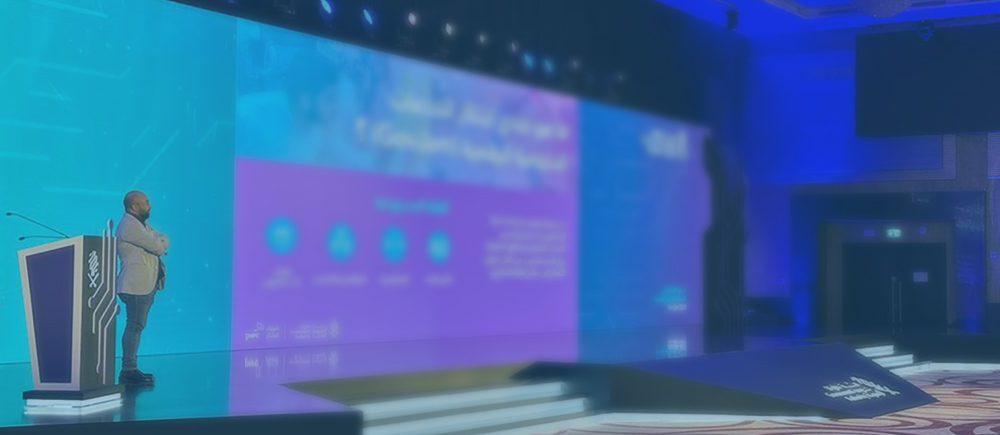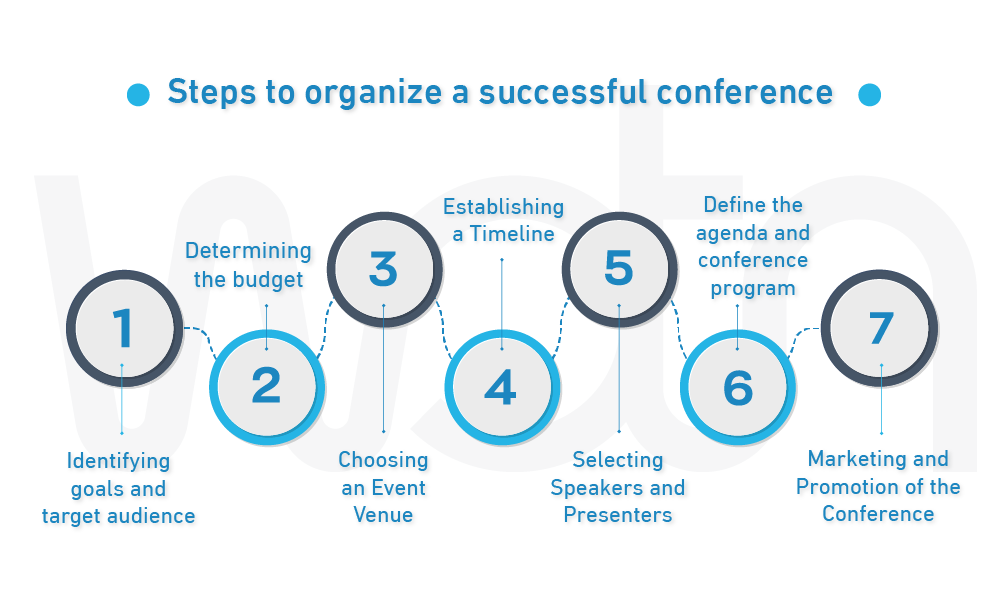Your Vision, Delivered
Say hello to the real experience!
Bring your next event to life—guided by experience, innovation, and excellence.
Let’s create together
Who hasn't heard of or witnessed a successful conference that impresses attendees with exceptional content and enriches them with valuable new ideas? However, this impressive success doesn't happen by chance but requires careful planning and professional execution. A conference isn't just a simple gathering but an event that disseminates knowledge, expertise, and innovation while building networks of collaboration and partnership. Thus, to organize a successful conference requires a clear and well-thought-out plan, whether it's an in-person or virtual conference.
In this article, we present a comprehensive guide that outlines planning and organizing a successful conference in seven key steps. From establishing clear objectives and identifying your event's target audience, curating a lineup of speakers, forging partnerships with collaborators and sponsors, and implementing effective promotional strategies to maximize attendance and engagement. By the conclusion, you will possess the expertise to orchestrate a conference that surpasses your expectations, achieves your desired goals, and leaves a lasting impression on your attendees.
Planning and organizing conferences play a pivotal role in determining their success or failure. They help you to establish clear goals, identify your target audience, develop a program, and set a budget.
Effective organization is critical to execute your plan professionally and manage partners, sponsors, speakers, and attendees seamlessly. By following these essential steps, you can ensure a smooth and efficient conference that meets your objectives. Let's explore these steps together and learn how to plan and organize a successful event.

To organize a successful conference, you must start by defining its objectives and target audience. Without this step, you risk creating a conference that fails to meet the needs and expectations of your audience, and you may struggle to choose the right content and format. Begin by asking yourself what message you want to convey, what value you want to offer your attendees, and what results you hope to achieve.
By understanding your goals and audience, you can design a conference that resonates with your participants and delivers the desired outcomes. Your conference goals may vary, from sharing novel ideas or information in your field, to promoting your organization or building a network of potential partners. So, defining your conference's primary objective is crucial as it guides the rest of your planning and decision-making. By having a clear objective, you can tailor the details and plans that will lead to a successful conference.
A critical step in organizing a successful conference is determining the budget. This involves estimating the funds required to cover all expenses and revenues associated with the event. Defining the budget is crucial as it enables meticulous planning, execution, and evaluation of the conference, while preventing any potential shortfalls or excesses. To accurately determine the budget, it's essential to follow a structured approach, which includes the following steps:
These are the various sources of funding that can contribute to the conference budget, including registration fees, sponsorships, advertising, grants, donations, support from relevant organizations, and other revenue streams such as product or service sales. Each funding source should be carefully evaluated to realistically and logically estimate its value, while considering any associated conditions or restrictions.
This involves identifying and estimating the various expenses associated with organizing the conference. Some common expenses include venue rental, audiovisual equipment, catering, speaker fees, marketing and promotional costs, staff and volunteer expenses, transportation, accommodations, and any other necessary expenditures. It is important to carefully consider all potential expenses to ensure an accurate budget estimation.
Creating a comprehensive budget table that lists all revenue sources and expenses for the conference is essential. This table should be flexible and adaptable to changes that may arise during the planning or execution process.
Selecting the right venue is the third crucial step in organizing a successful conference. The venue's location is key in setting the tone and ambiance of the conference, ensuring the satisfaction of attendees, speakers, and partners. To ensure a seamless and efficient event, you must choose a venue that aligns with the conference's nature, theme, and size, and provides all the services and facilities. When selecting the venue, consider additional factors such as:
Geographic location: Choosing a venue that is easily accessible to attendees, speakers, and partners, whether they are local or from out of town, is crucial. Ideally, the venue should be located near airports, train stations, and public transportation hubs, and offer transportation and accommodation services for guests. Additionally, it's important to consider the venue's location in terms of safety, peacefulness, and attractiveness.
Space and design: The chosen venue must be able to accommodate the anticipated number of attendees, speakers, partners, and the organizing team comfortably. It should have sufficient space, including suitable rooms and halls for hosting various sessions, workshops, presentations, and interactive activities. The venue should also be equipped with the latest audiovisual technologies and equipment, along with high-speed internet service. Proper ventilation and lighting systems must be ensured to create a comfortable and conducive environment for all participants.
Cost and quality: It's important to establish a specific budget for rental and compare offers from different conference service providers. Choosing a venue that offers the best value for money and provides high-quality services and facilities is crucial. It's also essential to verify the reputation and experience of the service provider by requesting examples of previous conferences they have hosted or organized.
Choosing the right date for your conference is crucial to ensuring its success. To attract the appropriate participants, it's important to avoid scheduling your event during dates that coincide with other industry events. Additionally, you should steer clear of times when potential attendees are occupied with holidays, vacations, or exams.
It's also essential to consider external factors such as the weather, political climate, and security conditions of the city where the conference will take place. Determining the duration of your conference is crucial, as it can significantly impact the quality of content and the effectiveness of participation. It's important to set the duration thoughtfully, taking into consideration the content you intend to deliver and the expectations of your participants.
Strive to strike a balance that keeps the conference engaging and informative without causing participants to lose interest or feel fatigued. Avoid making the conference too short, as it can result in a loss of effectiveness, or too long, as it can lead to diminishing returns.
The speakers and presenters are the heart of a successful conference, as they provide a wealth of knowledge, ideas, and expertise that enrich the event. Therefore, it's crucial to approach their selection with careful consideration and attention to specific and innovative criteria, such as:
To choose the speakers, presenters, and participants, you can follow the following steps:
After selecting the speakers and presenters for the conference, the sixth step is to define the agenda and conference program. If you find it confusing to differentiate between the agenda and the conference program, simply put, the agenda is a list of sessions, activities, and events that will take place at the conference, specifying the time, duration, and nature of each.
On the other hand, the conference program is a detailed plan on how to execute the agenda, including assigning responsibilities, allocating resources, and outlining the necessary procedures. By following the following steps, we can transform the conference agenda and program into an engaging and attention-grabbing Visitor Experience for participants, while keeping their focus throughout the duration:
Creating a unique and effective promotional plan is critical to the success of your conference. To attract interest and stand out from the competition, you need to develop a plan that goes beyond traditional strategies.
This can include launching a comprehensive website that provides all the necessary information about the conference, creating promotional materials that reflect the conference's identity and message, and distributing them in targeted locations.
You can also leverage media channels to increase exposure for your conference. To take it a step further, consider exploring innovative ways to promote the event, such as utilizing virtual reality technology or providing unique souvenirs for participants. By embracing creative approaches, you can generate excitement and interest in your conference, and attract a wider audience. After following the essential steps to organize a successful conference, it's crucial to evaluate the event and identify its strengths and weaknesses.
This evaluation process allows you to identify areas that require improvement and build on the conference's strengths for future events. By leveraging these insights, you can continuously improve the quality and effectiveness of your conferences, and provide an even better experience for participants in the future.
Read More: Planning and Managing Exhibitions: A Guide to the Success of Your Trade Exhibition

However, always remember that when you make the decision to organize a conference, you are opening the door to effort, creativity, and deep thinking. Surely, you will witness remarkable results that are worth this endeavor.
If you find yourself in need of assistance or support in organizing your upcoming conference, our creative team is here to help. We offer quality, value, and excellence in event organization, including conference management, symposium organization, and workshop management.
We are committed to delivering intelligent and cutting-edge solutions that are customized to meet your specific requirements and surpass your expectations. Together, we can venture on an exciting journey to create an unforgettable conference experience for everyone in attendance.
Say hello to the real experience!
Bring your next event to life—guided by experience, innovation, and excellence.
Let’s create together
